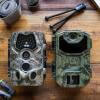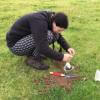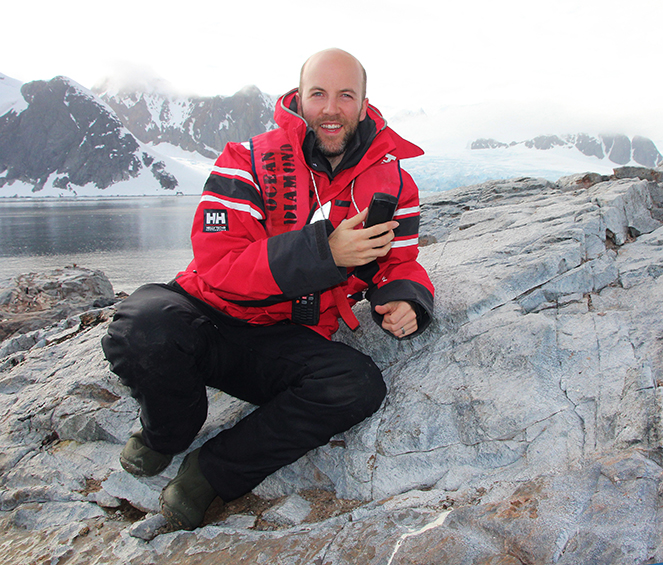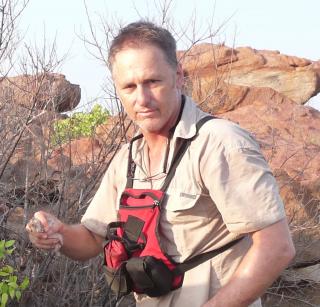Camera traps have been a key part of the conservation toolkit for decades. Remotely triggered video or still cameras allow researchers and managers to monitor cryptic species, survey populations, and support enforcement responses by documenting illegal activities. Increasingly, machine learning is being implemented to automate the processing of data generated by camera traps.
A recent study published showed that, despite being well-established and widely used tools in conservation, progress in the development of camera traps has plateaued since the emergence of the modern model in the mid-2000s, leaving users struggling with many of the same issues they faced a decade ago. That manufacturer ratings have not improved over time, despite technological advancements, demonstrates the need for a new generation of innovative conservation camera traps. Join this group and explore existing efforts, established needs, and what next-generation camera traps might look like - including the integration of AI for data processing through initiatives like Wildlife Insights and Wild Me.
Group Highlights:
Our past Tech Tutors seasons featured multiple episodes for experienced and new camera trappers. How Do I Repair My Camera Traps? featured WILDLABS members Laure Joanny, Alistair Stewart, and Rob Appleby and featured many troubleshooting and DIY resources for common issues.
For camera trap users looking to incorporate machine learning into the data analysis process, Sara Beery's How do I get started using machine learning for my camera traps? is an incredible resource discussing the user-friendly tool MegaDetector.
And for those who are new to camera trapping, Marcella Kelly's How do I choose the right camera trap(s) based on interests, goals, and species? will help you make important decisions based on factors like species, environment, power, durability, and more.
Finally, for an in-depth conversation on camera trap hardware and software, check out the Camera Traps Virtual Meetup featuring Sara Beery, Roland Kays, and Sam Seccombe.
And while you're here, be sure to stop by the camera trap community's collaborative troubleshooting data bank, where we're compiling common problems with the goal of creating a consistent place to exchange tips and tricks!
Header photo: Stephanie O'Donnell
- 0 Resources
- 0 Discussions
- 13 Groups
Spanish veterinarian interested in wildlife conservation
- 0 Resources
- 0 Discussions
- 14 Groups
- @CaseyAliveAI
- | He/Him
I'm an AI developer focused on ecology and the director of Alive AI
- 0 Resources
- 0 Discussions
- 4 Groups
- @team
- | team
Make the stories that make this life worth living.

- 0 Resources
- 2 Discussions
- 6 Groups
Software engineer
- 0 Resources
- 3 Discussions
- 4 Groups
- @Mumonkan
- | he / him
Conservation X Labs & Wild Me
Software Engineer for Wildlife Conservation

- 0 Resources
- 4 Discussions
- 11 Groups
- @aranFish
- | He/Him
CTO at SafetyNet Technologies


- 1 Resources
- 1 Discussions
- 6 Groups
- @ajcatella
- | he/him
I work as a BI Consultant, specialising in Power BI and am passionate about wildlife, particularly in Africa
- 0 Resources
- 3 Discussions
- 8 Groups
- @asime
- | He
I am Asime Oba a passionate conservationist with a strong background in microbiology and environmental science and a deep commitment to preserving, protecting and conserving wildlife and wild places in the Niger Delta region of Nigeria.
- 0 Resources
- 0 Discussions
- 4 Groups
- @SZaluski
- | her, she
- 0 Resources
- 0 Discussions
- 3 Groups
- @hannahrisser
- | She/her
CEH
- 0 Resources
- 0 Discussions
- 10 Groups
- @Mathilde
- | she/her
Natural Solutions
Engineer, I work for a web development company on web application projects for biodiversity conservation. I'm especially interested by camera traps, teledetection and DeepLearning subjects.
- 0 Resources
- 0 Discussions
- 11 Groups
Are you an architect, engineer, designer or a scientist? Can you design and manufacture a prototype open source plant-BES (bio electrochemical system) to power a camera trap and environmental sensors in tropical forests...
3 April 2018
Hundreds of people joined our #Tech4Wildlife photo challenge this year, showcasing all the incredible ways tech is being used to support wildlife conservation. We've seen proximity loggers on Tasmanian Devils in...
3 March 2018
‘The Field’… Say the words ‘The Field’ to a group of conservationists and it will immediately conjure up vivid memories of everything from sticky wet rainforests to burning dusty deserts. What’s more, it’s almost...
17 January 2018
Article
A new research project is looking to investigate whether technology combined with the ancient skills and knowledge of Namibian trackers can help save cheetahs from extinction. Called FIT Cheetahs, the research project...
4 December 2017
Our panel of international experts has been hard at work reviewing the 47 proposals we recieved for innovative technological tools to address human wildlife conflict. The panelists have systematically been assessing the...
20 October 2017
The inherent complexity of not only deploying technologies in the field but also doing so in a scientifically rigorous manner can prove a substantial barrier for the effective use of conservation technologies, and clear...
11 October 2017
Article
As pressure on marine resources increases, fishers have to explore deeper and deeper waters to make a living. What does this mean for Belize’s deep-sea sharks? In an effort to understand the threats to these animals,...
26 September 2017
Frustrated by the limitations of the tools that were available for managing large camera trap data sets, Heidi Hendry and Chris Mann set out to develop something that met their needs, and thus, Camelot was born. In...
7 July 2017
Article
There is a revolution coming in conservation. Advances in conservation technology are generating more data than ever before on what lives where, who eats who, and what’s disappearing and how fast, but it still requires...
10 May 2017
In this From the Field interview, we speak to Dr. Raman Sukumar, a world renowned expert on Asian elephant conservation. He shares his thoughts on how technology could be used for mitigating elephant-human conflict, and...
5 April 2017
The Camera Traps group is one the most active in our community, with members keen to discuss approaches to data management and processing, study design, and new software and hardware developments. Indeed, the top entry...
23 March 2017
Are you ready for this year's #Tech4Wildlife Photo Challenge? In anticipation, we're counting down our ten favourite entries from last year. Do you think you can top these?
1 March 2017
June 2025
July 2025
June 2020
October 2019
event
58 Products
Recently updated products
4 Products
Recently updated products
| Description | Activity | Replies | Groups | Updated |
|---|---|---|---|---|
| Hey there! Not sure what your funding constraints are but I have been using Reolink Go PT, which is solar powered. This model has been discontinued. However they have an upgraded... |
|
Camera Traps | 2 years 2 months ago | |
| We have made available our underwater videos on YouTube as a playlist https://www.youtube.com/playlist?list=PLnhVZKKy8WkZKriCIV6r7upWhHNVrU_7L It's about 1.113 short video... |
+2
|
AI for Conservation, Camera Traps, Data management and processing tools, Marine Conservation | 2 years 2 months ago | |
| Hi Steph, This should be a simple project. Recently I came across a website with a sample video I am not sure whether it was from the wild Labs website. Where a camera is... |
|
AI for Conservation, Camera Traps | 2 years 2 months ago | |
| @Stephanie well this just goes to show how good Browning market segmentation is :) Yes -- it sounds like the "clickless" Patriot is a good choice for you. I am in the... |
|
Camera Traps | 2 years 2 months ago | |
| Hi Vishnu,Considering only motion detection video, it is possible to modify (most) camera traps to trigger an external piece of equipment like an audio recorder. I'm not... |
|
Camera Traps | 2 years 3 months ago | |
| Hi Titus,If the usual syntactic foam sources aren't available, an option may be to add an empty dry housing or use a larger housing for the BRUV, just to provide the buoyancy.You... |
|
Camera Traps, Emerging Tech, Open Source Solutions | 2 years 3 months ago | |
| Hey Tom,Since the output is dependent on a couple of factors such as the solar irradiance of the place, shading from the canopy, the type of solar panels (mono, poly or amorphous... |
|
Autonomous Camera Traps for Insects, Build Your Own Data Logger Community, Camera Traps, Conservation Tech Training and Education, Sensors | 2 years 3 months ago | |
| Hi @timmh I've posted a link to this on Twitter too so fingers crossed you get some replies! All the best, Rob |
|
Camera Traps | 2 years 3 months ago | |
| The PIR motion sensor is at the top of the device board. You can see they are using a 3-pin analog motion sensor. From there it goes into a processing circuit. Unfortunately it... |
|
Camera Traps | 2 years 4 months ago | |
| My original background is in ecology and conservation, and am now in the elected leadership of the Gathering for Open Science Hardware which convenes researchers developing open... |
|
AI for Conservation, Animal Movement, Camera Traps, Conservation Tech Training and Education, Data management and processing tools, Drones, Emerging Tech, Sensors | 2 years 4 months ago | |
| Hi Ellie, did you compile this information and is it avaiblable somewhere?I need to upgrade the camera system in Baiboosun Nature Reserve Kyrgyzstan and this info would be of... |
+36
|
Camera Traps | 2 years 4 months ago | |
| Hi everyone, I seek your help for the choice of my thesis subject, I hold a Master's degree in Management of protected areas and I have... |
|
Camera Traps, Data management and processing tools, Protected Area Management Tools, Geospatial | 2 years 4 months ago |














































